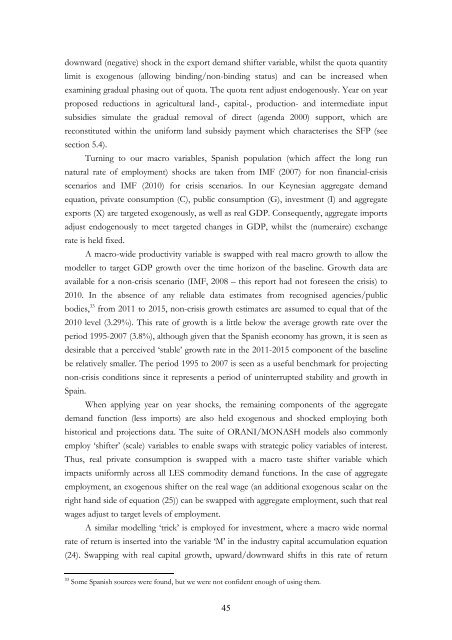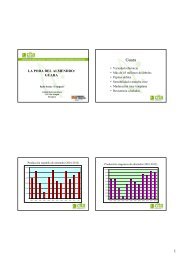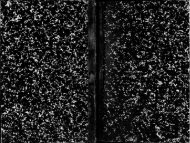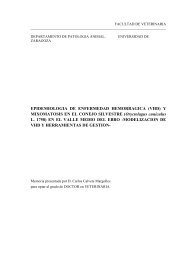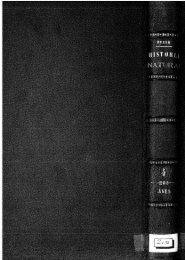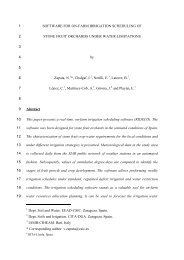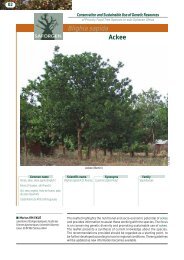1 A Recursive Dynamic Computable General Equilibrium Model For ...
1 A Recursive Dynamic Computable General Equilibrium Model For ...
1 A Recursive Dynamic Computable General Equilibrium Model For ...
You also want an ePaper? Increase the reach of your titles
YUMPU automatically turns print PDFs into web optimized ePapers that Google loves.
downward (negative) shock in the export demand shifter variable, whilst the quota quantity<br />
limit is exogenous (allowing binding/non-binding status) and can be increased when<br />
examining gradual phasing out of quota. The quota rent adjust endogenously. Year on year<br />
proposed reductions in agricultural land-, capital-, production- and intermediate input<br />
subsidies simulate the gradual removal of direct (agenda 2000) support, which are<br />
reconstituted within the uniform land subsidy payment which characterises the SFP (see<br />
section 5.4).<br />
Turning to our macro variables, Spanish population (which affect the long run<br />
natural rate of employment) shocks are taken from IMF (2007) for non financial-crisis<br />
scenarios and IMF (2010) for crisis scenarios. In our Keynesian aggregate demand<br />
equation, private consumption (C), public consumption (G), investment (I) and aggregate<br />
exports (X) are targeted exogenously, as well as real GDP. Consequently, aggregate imports<br />
adjust endogenously to meet targeted changes in GDP, whilst the (numeraire) exchange<br />
rate is held fixed.<br />
A macro-wide productivity variable is swapped with real macro growth to allow the<br />
modeller to target GDP growth over the time horizon of the baseline. Growth data are<br />
available for a non-crisis scenario (IMF, 2008 – this report had not foreseen the crisis) to<br />
2010. In the absence of any reliable data estimates from recognised agencies/public<br />
bodies, 33 from 2011 to 2015, non-crisis growth estimates are assumed to equal that of the<br />
2010 level (3.29%). This rate of growth is a little below the average growth rate over the<br />
period 1995-2007 (3.8%), although given that the Spanish economy has grown, it is seen as<br />
desirable that a perceived ‘stable’ growth rate in the 2011-2015 component of the baseline<br />
be relatively smaller. The period 1995 to 2007 is seen as a useful benchmark for projecting<br />
non-crisis conditions since it represents a period of uninterrupted stability and growth in<br />
Spain.<br />
When applying year on year shocks, the remaining components of the aggregate<br />
demand function (less imports) are also held exogenous and shocked employing both<br />
historical and projections data. The suite of ORANI/MONASH models also commonly<br />
employ ‘shifter’ (scale) variables to enable swaps with strategic policy variables of interest.<br />
Thus, real private consumption is swapped with a macro taste shifter variable which<br />
impacts uniformly across all LES commodity demand functions. In the case of aggregate<br />
employment, an exogenous shifter on the real wage (an additional exogenous scalar on the<br />
right hand side of equation (25)) can be swapped with aggregate employment, such that real<br />
wages adjust to target levels of employment.<br />
A similar modelling ‘trick’ is employed for investment, where a macro wide normal<br />
rate of return is inserted into the variable ‘M’ in the industry capital accumulation equation<br />
(24). Swapping with real capital growth, upward/downward shifts in this rate of return<br />
33 Some Spanish sources were found, but we were not confident enough of using them.<br />
45


